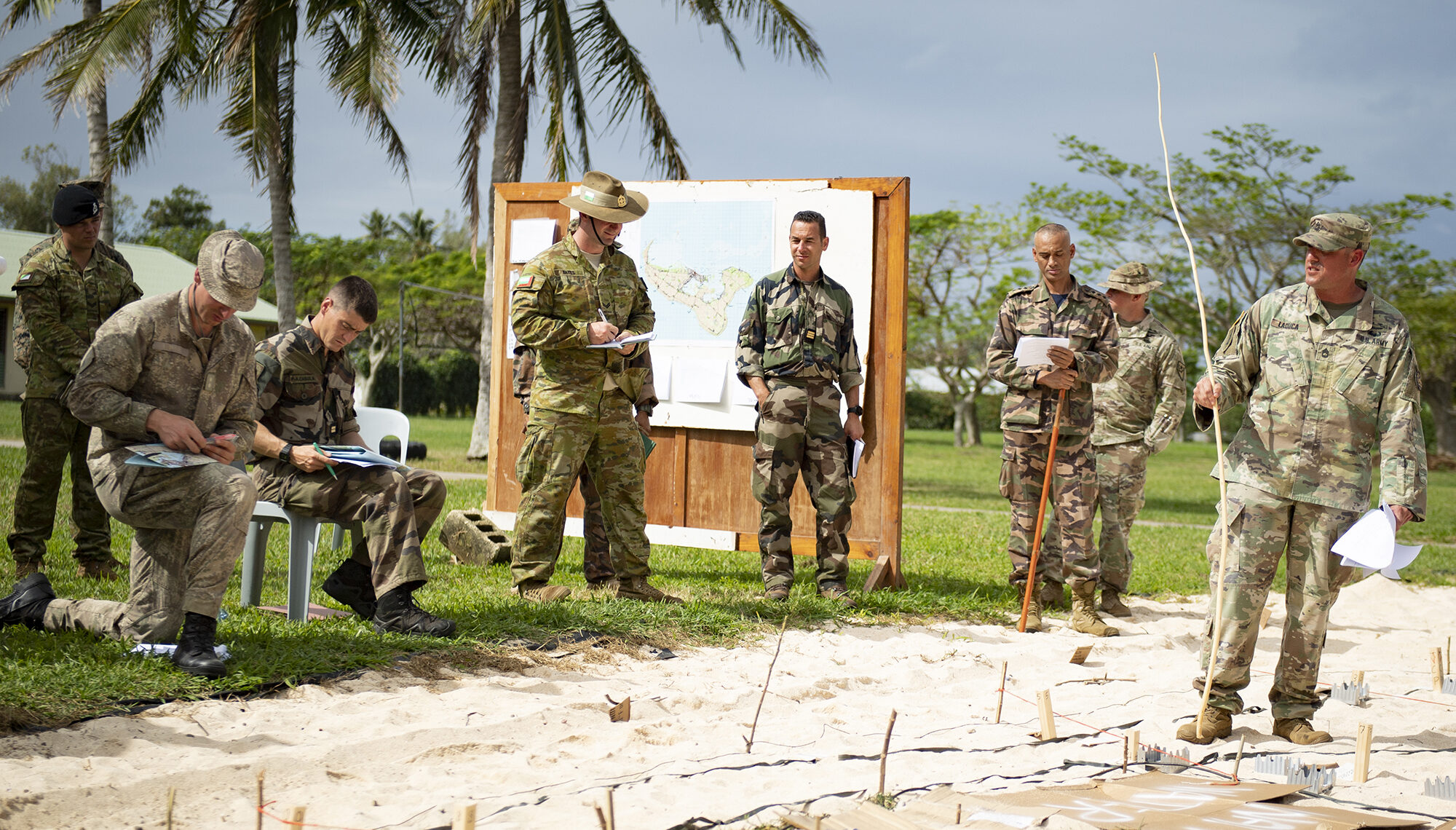CHANGES TO DOCTRINE AND PROCESSES: ENHANCING INTEROPERABILITY
By Chief Instructor, Tactical School
This series, written by the Chief Instructor of Tactical School, is comprised of three individual articles that will be published individually in succession over the period of 10 days. The three articles are titled: Tactical and Planning Excellence: Changes to the NZ Army’s Planning Doctrine and Tactical School Courses, Changes to Doctrine and Process: Enhancing Interoperability, and Teaching Tactics: Changes to the Grade 2 and Grade 3 Courses. This is article two in the series and will detail the changes being made to the NZ Army’s planning doctrine and processes.
A Revised Planning Process for the NZ Army
The NZ Army’s new Military Appreciation Process is once again based upon the Australian Army’s LWD 5-1-4 Military Appreciation Process doctrine. A small number of NZ-specific modifications to the LWD process have been made, following direction from the LCC to maximise a manoeuvrist mind-set and ensure wide-ranging interoperability across ABCA forces:
- The NZ Army will continue to use the US Army’s Warfighting Functions (WFF), with the addition of ‘Influence Activity’, instead of the Australian Army’s Battlefield Operating Systems; and
- The Australian Army’s concept of developing an operational framework in their ‘Decisive Events’, which is expressed as an intent paragraph, is further refined in a NZ Army specific approach to align with the US Army’s decisive / shaping / sustaining framework linked to US Army’s definition of defeat and stability mechanisms.
Returning to the 5-step LWD 5-1-4 process ensures our thinking and planning follows with the Australian MAP while being aligned with other partner forces, most notably the United States Army. It also returns us to a unified planning hierarchy where our combat, individual, staff and joint appreciation processes link together and share a common foundation in Australian doctrine.
The New NZP 86-1 Staff Officers Handbook
To support and enable effective planning, both during instruction and training on TRADOC courses and when working in real-world headquarters, a new NZP 86-1 Staff Officers Handbook has been developed and approved for release. This sees a return to the NZP 86 Staff Officer Handbook series of publications that was last issued in 2011 and replaced during the 2015/16 Tactical School course revisions. The NZP 86 will not replace the NZP 61-1 (NZ) Bde Standard Operating Procedures series, which are focussed on technical execution of tactical tasks. Rather, the NZP 86 series is focussed on generic staff processes and is designed as a universal reference for staff officers, providing a single point of reference for generic tactical planning.
 The NZP 86-1 Staff Officer Handbook is intended to be the first of three complementary volumes in the NZP 86 series:
The NZP 86-1 Staff Officer Handbook is intended to be the first of three complementary volumes in the NZP 86 series:
- NZP 86-1 – The Military Appreciation Process is focussed on detailing the planning process and providing the necessary references for conducting an individual or staff planning activity.
- NZP 86-2 – Planning References will contain references and data needed to support a planning process.
- NZP 86-3 – Organisations for Battle (ORBATs) will contain real-world and planning-specific ORBATs (replacing the TRADOC Coalition Forces Battle Book for training purposes).
The NZP 86-1 was first released in October last year and has already undergone an initial round of feedback and refinements. A new edition, the NZP 86-1 v2022, has been released and is now available on the Land Operations Doctrine and Tactical School intranet pages.
Staff officers involved in tactical planning should refer to the NZP 86-1 to familiarise themselves with the updated process and templates. It should remain a familiar process when compared to the old Tactical School MAP as both were based on the Australian 5-1-4, but the new process has returned to the simplified and stream-lined Australian process without the additional steps of the old NZ process, and the joint-level references and planning tools have been removed in favour of tactically-orientated steps and outputs.
The NZP 86-1 has been designed as a universal reference for general tactical planning, and should provide all templates, steps and guides needed to conduct, lead or participate in a planning process.
The NZ Army’s Operational Framework
The Australian Army’s Decisive Events framework has been identified as an effective way of developing and expressing a commander’s intent, but analysis indicated that it was at times difficult to ascertain a main effort, a ‘battle-winning idea’ and a clear theory and method for mission success. For example an Australian method statement could look like the following:
We will fix the delay Bn on position and neutralise their brigade artillery group in predictable locations thereby isolating them; draw the Bn counter-attack reserve into complex terrain, functionally dislocating them; then trigger the enemy delay Bn to withdraw through tempo of advance on the western flank. We will then destroy the enemy delay Bn on their withdrawal route, physically dislocating their ability to fight from a prepared defensive position. This will be followed by a clearance of the MSR, securing a BHL and Bn AA; conduct immediate reorg for 1 x BG and the conduct of an FPoL with 3 MCB.
The NZ MAP still uses the same Australian process for generating events, but instead of combining them in a single paragraph they are now expressed in terms of a single Decisive Event, a series of Shaping Events and a series of Sustaining Events, as per US Army doctrine.
In addition, the NZ Army Decisive / Shaping / Sustaining events framework includes the use of clearly defined US Army defeat and stability mechanisms, while the Australian Army allows (but does not define) the defeat mechanisms that can be incorporated in the framework.
Using the above example, the same method statement and events expressed in the NZ Army operational framework could look like:
The Decisive Event is the destruction of the enemy delay Bn on their withdrawal route, which physically dislocates their ability to fight from a prepared defensive position.
Shaping Events include:
- fixing the delay Bn on position and conforming to the enemy commander’s expectations of a quick attack;
- neutralising their brigade artillery group in predictable locations, isolating the delay Bn;
- Functionally dislocating the Bn counter-attack reserve by drawing it into complex terrain; and
- triggering the enemy delay Bn to withdrawal early through the tempo of our advance on the enemy’s western flank.
Sustaining Events include:
- clearing the MSR;
- securing a BHL and Bn AA;
- conduct immediate reorg for 1 x BG;
- conduct FPoL with 3 MCB.
This should provide greater clarity and ensure that plans are designed and expressed simply and concisely, enabling a strong manoeuvrist approach to be ingrained in all NZ Army planners. The NZP 86-1 (Section 3) provides further details.
Other Planning Changes of Note
Of particular interest to officers who have gone through Tactical School courses previously, some minor but potentially important change has been made to ensure that NZ Army doctrine and planning terminologies align with both foreign planning processes and our own joint-level doctrine.
The definition of Sequel Phases. Historically, Tactical School has taught that ‘Sequel’ phases occur automatically after the end of a planned activity, phase or end-state. Doctrinally this definition is at odds with our primary reference (LWD 5-1-4) and our joint level planning doctrine (ADFP 5.0.1). Both our primary references and overseas planning processes refer to a ‘Sequel’ as a type of contingency plan that is executed if there is a change in the mission and a new end-state arises (for example, an enemy force withdraws early, and the friendly force mission changes from a deliberate attack to destroy them to a pursuit to secure key bridges). To realign NZ Army practices with primary doctrine and overseas practices, the NZP 86-1 clarifies our use of the term ‘sequel’.

Figure 1: Previous NZ Army / Tactical School use of ‘Sequel’ Planning as a Phase

Figure 2: Updated NZ Army / Tactical School use of ‘Sequel’ Planning as Contingency Planning
Centre of Gravity (COG) analysis. The COG analysis taught at Tactical School has been realigned to the Australian LWD 5-1-4 process that is orientated towards tactical-level, actionable outputs. Some additional guidance and formats to assist a tactical-level commander or staff officer in conducting a COG analysis is provided in the NZP 86-1 based off noted ABCA best practices, including the likes of the following table-based analysis format. The NZP 86-1 emphasises that the value from a COG analysis comes from a systems-based approach to understanding the enemy, and that there is no ‘one right’ answer.

Back-briefing Formats. A number of briefing steps and formats in the old NZ MAP have been discontinued to streamline the process and align it with the 5-step Australian MAP. In addition, back-briefing formats have been revised to reflect the revised NZ Army planning framework and combined arms focus, with areas such as Emission Control (EMCON) and Air Defence measures now being briefed. Those involved in preparing and delivering back-briefs as part of a staff are encouraged to refer to the current version of the NZP 86-1 to reference the latest back-briefing formats.
Force Ratio Analysis and NZ FORAGE. The LWD 5-1-4 appreciation process includes a specific step of allocating initial forces and comparing force rations when courses of action are being created. To support this, a number of options are provided in the NZP 86-1 to guide a force ratio comparison. This does not create artificial ‘science’ in tactics, but rather is a tool that a commander and staff can use when thinking about or discussing force ratios. Currently, the ‘3 to 1’ guide is the only force-ratio concept most NZ Army officers would think of when asked to consider force ratios, and the additional steps provide three possible ways of thinking about and analysing relative combat strength, all borrowed from foreign (Australian, UK, US and NATO) doctrine.
The NZP 86-1 provides all necessary details, but in support of this Tactical School has developed a Correlation of Forces calculator, the NZ Army Force Ratio Generator (NZ FORAGE). This is based off the US Army’s Correlation of Forces calculator and NATO’s FORAGE. NZ FORAGE, like all COF models, is only intended to assist in planning and wargaming as a tool adjacent to and supporting military judgement. NZ FORAGE is available from Tactical School’s homepage, or by contacting Tactical School via email (tactical.school@nzdf.mil.nz).

Factor Analysis Processes (3 Column Format and Staff Planning Lexicon). The NZP 86-1 (Section 10) details a formal factor analysis format, allowing a structured appreciation process to be followed during a MAP. This is not complex or complicated but helps a commander and their staff to interrogate the factors within a problem, and to record that analysis through deductions to a series of outputs.
The NZP 86-1 also provides a common set of classifications for a staff to record, classify and action conclusions resulting from a 3 column factor analysis.

Inclusion of Red Teaming techniques. Overseas best-practices in military planning often includes reference to red-teaming. The role of the red team is to challenge the perceived norms and assumptions of the commander and the staff to improve the validity and quality of the final plan. Red teaming is a deliberate application of independent critical thought and alternative perspectives to improve decision making.
The NZP 86-1 outlines four possible red-teaming techniques or tools that can be used as part of the MAP, all adapted from UK or US military red teaming guides. These include the ‘4 Ways of Seeing’, ‘5 Whys’, ‘What If? Analysis’ and ‘Premortem Analysis’. All techniques are introduced on the Grade courses and can be referenced in the NZP 86-1 (Section 13).






